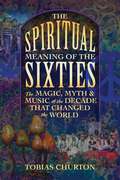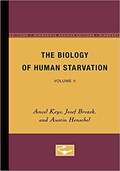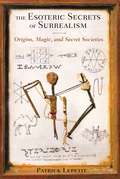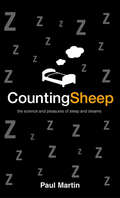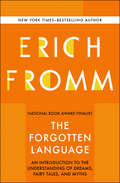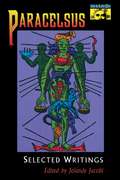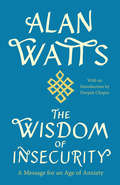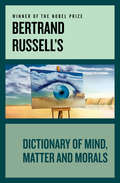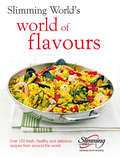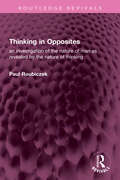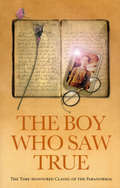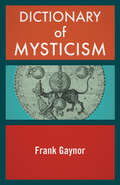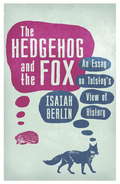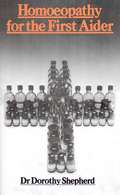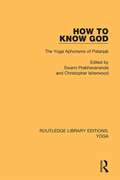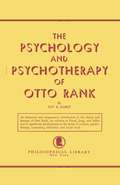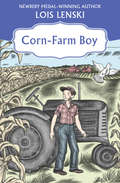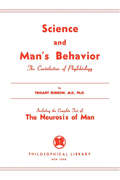- Table View
- List View
The Spiritual Meaning of the Sixties: The Magic, Myth, and Music of the Decade That Changed the World
by Tobias ChurtonUnveils the spiritual meaning that fueled the artistic, political, and social revolutions of the 1960s • Investigates the spiritual principles that informed everything from the civil rights and anti-war movements, to the hippies’ rejection of materialist culture, to the rise of feminism, gay rights, and environmentalism • Reveals how medieval troubadours, Gnosticism, Renaissance hermetic magic, and the occult doctrines of Aleister Crowley helped shape the psychedelic Sixties • Offers in-depth analysis of many of the era’s most famous books, films, and music No decade in modern history has generated more controversy and divisiveness than the tumultuous 1960s. For some, the ‘60s were an era of free love, drugs, and social revolution. For others, the Sixties were an ungodly rejection of all that was good and holy. Embarking on a profound search for the spiritual meaning behind the massive social upheavals of the 1960s, Tobias Churton turns a kaleidoscopic lens on religious and esoteric history, industry, science, philosophy, art, and social revolution to identify the meaning behind all these diverse movements. Engaging with views of mainstream historians, some of whom write off this pivotal decade as heralding an overall decline in moral values and respect for tradition, Churton examines the intricate network of spiritual forces at play in the era. He reveals spiritual principles that united the free love movement, the civil rights and anti-war movements, the hippies’ rejection of materialist culture, and the eventual rise of feminism, gay rights, and environmentalism. He traces influences from medieval troubadours, Gnosticism, Hindu philosophy, Renaissance hermetic magic, and the occult doctrines of Aleister Crowley. He also examines the psychedelic revolution, the genesis of popular interest in UFOs, and the psychological consequences of the Bomb and the assassinations of the Kennedys and Martin Luther King. In addition, Churton investigates the huge shifts in consciousness reflected in the movies, music, art, and literature of the era--from Frank Sinatra to the Beatles, from I Love Lucy to Star Trek, from John Wayne to Midnight Cowboy--much of which still resonates with the youth of today. Taking the reader on a long strange trip from crew-cuts and Bermuda shorts to Hair and Woodstock, from liquor to psychedelics, from uncool to cool, and from matter to Soul, Churton shows how the spiritual values of the Sixties are now reemerging, with an astonishing influx of spiritual light, to once again awaken us.
The Biology of Human Starvation: Volume II
by Ancel Keys Josef Brozek Austin HenschelThe Biology of Human Starvation was first published in 1950. Minnesota Archive Editions uses digital technology to make long-unavailable books once again accessible, and are published unaltered from the original University of Minnesota Press editions. <p><p> With great areas of the world battling the persistent and basic problem of hunger, this work constitutes a major contribution to needed scientific knowledge. The publication is a definitive treatise on the morphology, biochemistry, physcology, psychology, and medical aspects of calorie undernutrition, cachexia, starvation, and rehabilitation in man. <p><p> Presented critically and systematically are the fact and theory from the world literature, including the evidence from World War II and the finding of the Minnesota Starvation Experiment (1944*1946). Pertinent experiments and field and clinical observations to 1949 are covered. <p><p> The extensive original research involved was conducted at the University of Minnesota Laboratory of Physiological Hygiene, which Dr. Keys heads. The authors, all of the laboratory staff, were assisted in preparation of the work by Ernst Simonson, Samuel Wells and Angie Sturgeon Skinner.
The Esoteric Secrets of Surrealism: Origins, Magic, and Secret Societies
by Bernard Roger Patrick LepetitA profound understanding of the surrealists’ connections with alchemists and secret societies and the hermetic aspirations revealed in their works • Explains how surrealist paintings and poems employed mythology, gnostic principles, tarot, voodoo, alchemy, and other hermetic sciences to seek out unexplored regions of the mind and recover lost “psychic” and magical powers • Provides many examples of esoteric influence in surrealism, such as how Picasso’s Demoiselles d’Avignon was originally titled The Bath of the Philosophers Not merely an artistic or literary movement as many believe, the surrealists rejected the labels of artist and author bestowed upon them by outsiders, accepting instead the titles of magician, alchemist, or--in the case of Leonora Carrington and Remedios Varo--witch. Their paintings, poems, and other works were created to seek out unexplored regions of the mind and recover lost “psychic” and magical powers. They used creative expression as the vehicle to attain what André Breton called the “supreme point,” the point at which all opposites cease to be perceived as contradictions. This supreme point is found at the heart of all esoteric doctrines, including the Great Work of alchemy, and enables communication with higher states of being. Drawing on an extensive range of writings by the surrealists and those in their circle of influence, Patrick Lepetit shows how the surrealists employed mythology, gnostic principles, tarot, voodoo, and alchemy not simply as reference points but as significant elements of their ongoing investigations into the fundamental nature of consciousness. He provides many specific examples of esoteric influence among the surrealists, such as how Picasso’s famous Demoiselles d’Avignon was originally titled The Bath of the Philosophers, how painter Victor Brauner drew from his father’s spiritualist vocation as well as the Kabbalah and tarot, and how doctor and surrealist author Pierre Mabille was a Freemason focused on finding initiatory paths where “it is possible to feel a new system connecting man with the universe.” Lepetit casts new light on the connection between key figures of the movement and the circle of adepts gathered around Fulcanelli. He also explores the relationship between surrealists and Freemasonry, Martinists, and the Elect Cohen as well as the Grail mythos and the Arthurian brotherhood.
Counting Sheep: The Science and Pleasures of Sleep and Dreams
by Paul MartinDoes the early bird really catch the worm, or end up healthy, wealthy, and wise? Can some people really exist on just a few hours' sleep a night? Does everybody dream? Do fish dream? How did people cope before alarm clocks and caffeine? And is anybody getting enough sleep? Even though we will devote a third of our lives to sleep, we still know remarkably little about its origins and purpose. Paul Martin's Counting Sheep answers these questions and more in this illuminating work of popular science. Even the wonders of yawning, the perils of sleepwalking, and the strange ubiquity of nocturnal erections are explained in full. To sleep, to dream: Counting Sheep reflects the centrality of these activities to our lives and can help readers respect, understand, and extract more pleasure from that delicious time when they're lost to the world.
The First Book of Nurses
by Mary EltingThere are many different kinds of nurses--so many that you couldn't read about them all in one book. But all nurses are alike in these ways: They want to help you get well when you are sick; and, more than anything else, they want to help you stay well. This book tells how they do both these things. It tells about the people they meet and how they help them.
The Forgotten Language: An Introduction to the Understanding of Dreams, Fairy Tales, and Myths
by Erich FrommRenowned psychoanalyst Erich Fromm investigates the universal language of symbols, expressed through dream and myths, and how it illuminates our humanity. In this study, Erich Fromm opens up the world of symbolic language, &“the one foreign language that each of us must learn.&” Understanding symbols, he posits, helps us reach the hidden layers of our individual personalities, as well as connect with our common human experiences. By grasping the symbolic language of dreams, Fromm explains, we can then also understand the deeper wisdom of myths, art, and literature. This also gives us access to what we, and our society, usually repress. Fromm shares the history of dream interpretations, and demonstrates his analysis of many types of dreams. This ebook features an illustrated biography of Erich Fromm including rare images and never-before-seen documents from the author&’s estate.
Paracelsus: Selected Writings (Bollingen Series #680)
by ParacelsusThe enigmatic sixteenth-century Swiss physician and natural philosopher Philippus Aureolus Theophrastus Bombastus von Hohenheim, called Paracelsus, is known for the almost superhuman energy with which he produced his innumerable writings, for his remarkable achievements in the development of science, and for his reputation as a visionary (not to mention sorcerer) and alchemist. Little is known of his biography beyond his legendary achievements, and the details of his life have been filled in over the centuries by his admirers. This richly illustrated anthology presents in modernized language a selection of the moral thought of a man who was not only a self-willed genius charged with the dynamism of an impetuous and turbulent age but also in many ways a humble seeker after truth, who deeply influenced C. G. Jung and his followers.
The Wisdom of Insecurity: A Message For An Age Of Anxiety
by Alan W. WattsAn exploration of man's quest for psychological security and spiritual certainty in religion and philosophy.From the Trade Paperback edition.
Bertrand Russell's Dictionary of Mind, Matter and Morals
by Bertrand RussellThis dictionary contains more than 1000 selections from over 100 of Russell&’s books and articles. It serves as an introduction to Russell&’s brilliance in analysis, argument, and exposition which develops a clear notion of his method of approach, his fundamental principles and many of his leading ideas. Found here are definitions and terms reflected in the topics of mind, matter and morals.
Bertrand Russell's Dictionary of Mind, Matter and Morals
by Bertrand RussellThis dictionary contains more than 1000 selections from over 100 of Russell&’s books and articles. It serves as an introduction to Russell&’s brilliance in analysis, argument, and exposition which develops a clear notion of his method of approach, his fundamental principles and many of his leading ideas. Found here are definitions and terms reflected in the topics of mind, matter and morals.
Homoeopathic Drug Pictures
by Margaret L TylerNow in its fourth edition, this standard text on homoeopathy highlights different plants and the illnesses that can be treated by them.
Thinking in Opposites: an investigation of the nature of man as revealed by the nature of thinking (Routledge Revivals)
by Paul RoubiczekFirst published in 1952, Thinking in Opposites insists on the need for a carefully thought-out, rather than a merely authoritarian, basis for faith; but also insists that an indispensable preliminary is to know the laws which govern and limit the scope of human thinking in relation to three areas: the external world as it is; the internal world of feeling; and the interrelation of each of these with the other. This book is not a technical work in philosophy and the theory of knowledge; but it deals with problems in those fields which have usually been handled only in technical language. Therefore, this is a book both for the expert and for the intelligent and thoughtful layman: for the man who has a sense of responsibility for what he believes, and who is able to justify his faith amid the chaos of our times.
Angel Unaware
by Dale Evans RogersRobin Rogers tells the story of her two years on earth, and how she helped her parents, Roy Rogers and Dale Evans Rogers, toward a firm faith.
The Boy Who Saw True: The Time-Honoured Classic of the Paranormal
by AnonThe Boy Who Saw True is based on the diary entries of a young Victorian boy whose extraordinary supernatural talent reveals itself within these pages. By turns naïve, insightful, funny and moving, it is an extremely convincing account of a precocious paranormal talent, and all the more persuasive because the young diarist never sets out to win over his readers. Born with incredible clairvoyant powers, the anonymous author could see auras and spirits, yet failed to realise that other people were not similarly gifted. This remarkable book has become a paranormal classic.
Dictionary of Mysticism: Dictionary Of Mysticism, Encyclopedia Of Superstitions, And Dictionary Of Magic
by Frank GaynorMore than 2,200 terms defined in an essential reference on religious mysticism, esoteric philosophy, occultism, and more. Dictionary of Mysticism provides concise definitions for more than 2,200 terms used in many philosophies, religions, and doctrines which relate to the influence of the superhuman and supernatural on man&’s everyday life. Terms relating to esoteric philosophy, occultism, religious mysticism, spiritualism, alchemy, and psychical research are defined. Particular attention is given to the Eastern philosophies of Buddhism, Brahmanism, Sufism, Lamaism, Zoroastrianism, Theosophy, and Cabbalism. Also included are terms used in magic and demonology.
The Hedgehog And The Fox: An Essay on Tolstoy's View of History
by Isaiah BerlinIsaiah Berlin's classic essay on Tolstoy - an exciting new edition with new criticism and a foreword.'The fox knows many things, but the hedgehog knows one big thing.' This fragment of Archilochus, which gives this book its title, describes the central thesis of Isaiah Berlin's masterly essay on Tolstoy. There have been various interpretations of Archilochus' fragment; Isaiah Berlin has simply used it, without implying anything about the true meaning of the words, to outline a fundamental distinction that exists in mankind, between those who are fascinated by the infinite variety of things (foxes) and those who relate everything to a central all-embracing system (hedgehogs). When applied to Tolstoy, the image illuminates a paradox of his philosophy of history, and shows why he was frequently misunderstood by his contemporaries and critics. Tolstoy was by nature a fox, but he believed in being a hedgehog.
The Hedgehog And The Fox: An Essay on Tolstoy's View of History
by Isaiah BerlinIsaiah Berlin's classic essay on Tolstoy - an exciting new edition with new criticism and a foreword.'The fox knows many things, but the hedgehog knows one big thing.' This fragment of Archilochus, which gives this book its title, describes the central thesis of Isaiah Berlin's masterly essay on Tolstoy. There have been various interpretations of Archilochus' fragment; Isaiah Berlin has simply used it, without implying anything about the true meaning of the words, to outline a fundamental distinction that exists in mankind, between those who are fascinated by the infinite variety of things (foxes) and those who relate everything to a central all-embracing system (hedgehogs). When applied to Tolstoy, the image illuminates a paradox of his philosophy of history, and shows why he was frequently misunderstood by his contemporaries and critics. Tolstoy was by nature a fox, but he believed in being a hedgehog.
Homoeopathy For The First Aider
by Dr Dorothy ShepherdDr Dorothy Shepherd offers a guide to the medicinal treatment of first aid.For years she followed obediently the recognised, well-troden paths of antiseptic and aseptic wound treatment, with little or no medicinal aid, other than those already mentioned. She then had the opportunity to study and apply first-aid methods in surgical outpatients, private practice and a munition factory in the First World War and the later a minor ailment clinic. She gave up entirely the old methods and with the help of a devoted staff applied these comparatively new homoeopathic ideas which have proved successful.
How to Know God: The Yoga Aphorisms of Patanjali (Routledge Library Editions: Yoga #2)
by Swami Prabhavananda Christopher IsherwoodThe aphorisms collected in this book, first published in 1953, were composed by Patanjali, a great Indian sage, over 1,500 years ago, and here translated into clear English prose. The accompanying commentary interprets the sayings for the modern world, and in doing so gives a full picture of what yoga is, what its aims are, and how it can be practised.
The Psychology and Psychotherapy of Otto Rank: An Historical and Comparative Introduction
by Fay B. KarpfOtto Rank, an Austrian psychologist, was a protege of Sigmund Freud, who saw in young Rank a gifted mind and drew him into his inner circle. The Psychology and Psychotherapy of Otto Rank is author Fay B. Karpf s historical and comparative introduction to the theory and therapy of Otto Rank, his relation to Freud, Jung, and Adler and to significant developments in the fields of analysis, psychotherapy, counseling, education, and social work. Fay B. Karpf was one of the earliest Jewish American woman sociologists. Born in Austria in 1893, Karpf eventually immigrated to the United States, where she attended the University of Chicago. She immersed herself in the Chicago School of Sociology, and her first book, American Social Psychology: Its Origins, Development and European Background (1932), was a standard textbook in the field of social psychology. She studied with the psychoanalyst Otto Rank, and she later taught social work at the Training School for Jewish Social Work in New York. After the school unfortunately closed, Karpf moved with her husband to Los Angeles, where she became a practicing counselor and psychotherapist, and she continued contributing to the fields until her death in 1981.
Arthritis and Common Sense (3rd edition)
by Dan Dale AlexanderThis book tells the proper diet, the selection and rotation of food, plus a dietetic therapy, so that more of the correct oils in your food can serve the joints. It also shows how these oils can stimulate your adrenal glands--to successfully combat arthritis. In addition to the special diet which the author explains in the book, he also advocates the use of cod liver oil.
Corn-Farm Boy
by Lois LenskiAn Iowa farm boy longs to quit school and join his dad working the land Dick comes home from school early and tells his mother he was sent home with a stomachache. She puts him to bed and tells him to get some sleep, but Dick can't shut his eyes for a second. All his life he's wanted to be a farmer--to quit school and join his father and brother driving tractors across their sprawling property--and today is his chance. His father is getting a 2nd tractor, and he'll need Dick to drive it. Dick is certain that there's nothing on the farm that he can't handle. But when he gets a taste of farmer's work, will he be so sure it's the life for him? This charming novel offers a detailed look at life on a farm and a snapshot of a time when a boy could quit school to work in the fields.
Immortality: The Scientific Evidence
by Alson J. SmithThe astonishing case for life after death as revealed through the revolutionary science of parapsychology
Nature Cure
by M. K. GandhiThis book contains a valuable collection of Gandhiji’s thoughts on Nature Cure etc. and is indeed as rich in its information as it is constructive in its outlook. I commend this book for serious study by all those who are interested in cure of ailments through natural remedies. - Morarji Desai, 30th November, 1954
Science and Man's Behavior
by Trigant BurrowEdited and compiled by William E. Galt after Burrow's death, Science and Man's Behavior: The Contribution of Phylobiology details the practices and therapies of one of the founding fathers of behavioral psychology. As a psychologist, Burrow was most interested in understanding and resolving man's behavioral conflict. He worked to shed light on behavioral disorders through his use of group- and phylo-therapy. Join Galt on a journey through Burrow's theories and practices in this important early text on a groundbreaking twentieth-century methodology. Trigiant Burrow was a founder of phylobiology and was a pioneer of using phyloanalysis as a therapy tool. Burrow was a trained doctor, biologist, and psychologist who specialized in experimental psychology. He studied psychoanalysis with Carl Jung and brought the European techniques to the United States. He studied and practiced experimental and behavioral psychology in Baltimore, Maryland for most of his life.
